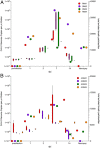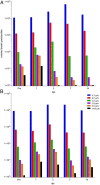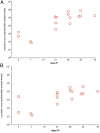Exhaled aerosol increases with COVID-19 infection, age, and obesity
- PMID: 33563754
- PMCID: PMC7923364
- DOI: 10.1073/pnas.2021830118
Exhaled aerosol increases with COVID-19 infection, age, and obesity
Erratum in
-
Correction for Edwards et al., Exhaled aerosol increases with COVID-19 infection, age, and obesity.Proc Natl Acad Sci U S A. 2021 Jul 6;118(27):e2109720118. doi: 10.1073/pnas.2109720118. Proc Natl Acad Sci U S A. 2021. PMID: 34183423 Free PMC article. No abstract available.
Abstract
COVID-19 transmits by droplets generated from surfaces of airway mucus during processes of respiration within hosts infected by severe acute respiratory syndrome coronavirus 2 (SARS-CoV-2) virus. We studied respiratory droplet generation and exhalation in human and nonhuman primate subjects with and without COVID-19 infection to explore whether SARS-CoV-2 infection, and other changes in physiological state, translate into observable evolution of numbers and sizes of exhaled respiratory droplets in healthy and diseased subjects. In our observational cohort study of the exhaled breath particles of 194 healthy human subjects, and in our experimental infection study of eight nonhuman primates infected, by aerosol, with SARS-CoV-2, we found that exhaled aerosol particles vary between subjects by three orders of magnitude, with exhaled respiratory droplet number increasing with degree of COVID-19 infection and elevated BMI-years. We observed that 18% of human subjects (35) accounted for 80% of the exhaled bioaerosol of the group (194), reflecting a superspreader distribution of bioaerosol analogous to a classical 20:80 superspreader of infection distribution. These findings suggest that quantitative assessment and control of exhaled aerosol may be critical to slowing the airborne spread of COVID-19 in the absence of an effective and widely disseminated vaccine.
Keywords: COVID-19; aerosols; respiratory medicine; superspreaders.
Copyright © 2021 the Author(s). Published by PNAS.
Conflict of interest statement
The authors declare no competing interest.
Figures





Comment in
-
Does exhaled aerosol increase with COVID-19 infection correlate with body mass index-years?Proc Natl Acad Sci U S A. 2021 Jul 6;118(27):e2106088118. doi: 10.1073/pnas.2106088118. Proc Natl Acad Sci U S A. 2021. PMID: 34187894 Free PMC article. No abstract available.
-
Reply to Stohner: On the significance of BMI-age dependence of exhaled aerosol.Proc Natl Acad Sci U S A. 2021 Jul 6;118(27):e2107559118. doi: 10.1073/pnas.2107559118. Proc Natl Acad Sci U S A. 2021. PMID: 34187899 Free PMC article. No abstract available.
References
-
- Liu Y., et al. ., Aerodynamic analysis of SARS-CoV-2 in two Wuhan hospitals. Nature 582, 557–560 (2020). - PubMed
-
- Ruzycki C. A., Golshahi L., Vehring R., Finlay W. H., Comparison of in vitro deposition of pharmaceutical aerosols in an idealized child throat with in vivo deposition in the upper respiratory tract of children. Pharm. Res. 31, 1525–1535 (2014). - PubMed
Publication types
MeSH terms
Substances
Grants and funding
LinkOut - more resources
Full Text Sources
Other Literature Sources
Medical
Miscellaneous

